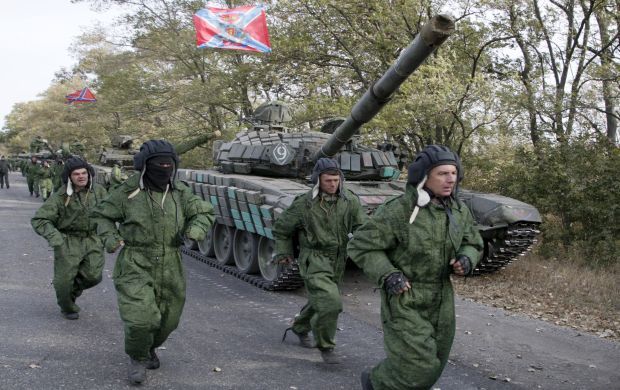
Conflict Conservation in Ukraine’s East Follows the Transnistria Model (Part One)
Publication: Eurasia Daily Monitor Volume: 17 Issue: 119
By:

“Frozen” is a Western mischaracterization of Russia’s protracted conflict undertakings against Moldova in Transnistria, against Georgia in Abkhazia and South Ossetia, and now of the desired end to Russia’s intervention in eastern Ukraine’s Donbas. Those conflicts never “froze” in a political sense—not even after the cessation of active hostilities in Moldova in 1992, in Georgia by fits and starts until 2008, and in Ukraine’s east with the July 22, 2020, enhanced ceasefire agreement. Instead of the immobility of a “freeze,” the cessation of hostilities has allowed steady movement toward political solutions favorable to Russia and its local protégés.
Freeze, moreover, implies a natural or spontaneous process; whereas the post-hostilities situation in Transnistria, Abkhazia and South Ossetia—and now looming in Ukraine’s east—reflects painstaking diplomatic efforts to reduce these conflicts to a permanently dormant state. Conflict conservation de facto on Russian terms became Western diplomacy’s fallback option instead of conflict resolution on Western terms, which seems unattainable or too costly. Conflict conservation, moreover, downgrades or sidelines these contentious issues on the West’s ambivalent agenda vis-à-vis Russia, as long as the West lacks an overall strategic agenda against Russia.
Transnistria became “the” pilot project for conflict conservation, in a tacit consensus between Russian and Western diplomacy, from 1992 to date; albeit with the supine acquiescence of Moldova as the object of aggression. Such acquiescence is one of the dissimilarities between this conflict and that in Ukraine’s east (and, earlier, in Georgia), along with the similarities. Ukrainian observers have been alert all along to the dangerous similarities with the Transnistria model of conflict conservation.
The Transnistria model helps to conserve three key sources of Moscow’s leverage: first, Russia’s military presence without a legal cover; second, a Russian-protected statelet, ideally but not necessarily under a constitutional cover squeezed out of the aggressed state (special status, federalization); and third, extensions of the Russian World inside the societies, cultures, and political systems of non-Russian countries.
These similarities are taking clearer shape following the July 22 enhanced ceasefire agreement and the Russo-German preconditions that have just been announced for holding another “Normandy Group” (Ukraine, Russia, Germany, France) summit. Ukraine obtained this latest ceasefire agreement at the price of quasi-recognizing and officializing Russia’s proxy forces in Donetsk and Luhansk while exonerating Russia of involvement in the conflict (see EDM, July 29, 30, August 5, 6). The Russo-German demands call for “full” compliance with “all” of the December 2019 Paris summit’s prescriptions to implement the Minsk “agreements” (Ukrinform, August 11).
Those Normandy prescriptions closely fit the logic of conflict conservation, namely: complete and comprehensive ceasefire between Ukrainian and Donetsk/Luhansk-flagged forces (just achieved on Russian terms—see above); step-by-step disengagement of troops along the demarcation line within Ukraine (instead of Russian withdrawal from Ukraine); opening checkpoints for movement across the demarcation line (de facto accepting the loss of Ukrainian control beyond the demarcation line); a Ukrainian „special status“ for the Russian-controlled territory, to be worked out between “the sides” (implying Kyiv and Donetsk-Luhansk, not Russia) in the Minsk Contact Group (see EDM, December 11, 12, 2019).
The model that has emerged in Transnistria over a 28-year period is broadly recognizable, albeit with necessary adjustments, in the Normandy and Minsk processes. Some elements of this model are unilateral Russian measures tolerated by Western diplomacy while other elements presuppose diplomatic coordination. The overall process involves:
1) Full, comprehensive ceasefire between legitimate state forces and Russia’s local proxies. Russia is exempted from its responsibility as conflict-initiator and belligerent, even as its own forces guarantee the territory’s seizure from the legitimate state. Legitimate forces and Russia’s proxies on either side of the demarcation line become coequal parties to the ceasefire arrangements, including verification and incident-response mechanisms. Russia has accomplished this stage in Moldova/Transnistria within a few short years after the 1992 ceasefire. The July 22, 2020, enhanced ceasefire agreement in Ukraine’s east opens this stage in that conflict.
2) Disengagement of forces at agreed distances from the demarcation line, whether in one fell swoop as in Transnistria’s case or piecemeal as proposed for Ukraine’s Donbas, where local disengagement zones would ultimately cover the full length of the demarcation line. A buffer zone takes shape under some uncertain policing rules. The pullback (“otvod”) from the demarcation line within the country becomes a long-term arrangement, instead of the declared goal of withdrawal (“vyvod”) of Russian forces from the country. Local and external actors shift their priorities from conflict resolution under international law toward stabilizing a new status quo. Russia unilaterally imposed these “new realities” on Moldova in 1992 and thereafter; Western diplomacy then took this accomplished fact on board. Russia now pursues a similar dispensation for Ukraine’s Donbas through the Normandy process (see above).
3) A “joint peacekeeping mechanism” involving the local legitimate state, Russia’s local proxies, and Russia itself, under Russia’s overall supervision, is Russia’s original contribution to the theory and practice of peacekeeping. It is a Russian discretionary arrangement outside any international framework. Moscow successfully introduced such “peacekeeping” in Moldova and Georgia in the early 1990s with passive Western acceptance. Russia dispensed with it after seizing Abkhazia and South Ossetia from Georgia in 2008, but it still needs such “peacekeeping” in the case of Moldova/Transnistria. Moscow failed to impose this system on Ukraine in Donbas. Only an embryo of this system emerged there with the Joint Center for Control and Coordination (JCCC), a ceasefire-monitoring body comprised of Russia and Ukraine, with a token presence of Donetsk-Luhansk, from 2014 to 2017. At present, Ukraine is coming under pressure to revive the JCCC as a bilateral structure of Kyiv and Donetsk-Luhansk, so as to further legitimize Russia’s proxy forces (see EDM, July 29, 30). In this conflict theater, however, the Organization for Security and Cooperation in Europe’s (OSCE) Special Monitoring Mission (a ceasefire-monitoring, not a peacekeeping mission) has somewhat helped restrain Russia’s freedom of action (see Part Two).



